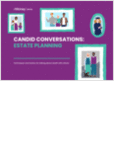If you think composing a good email to a client is as simple as dashing off a quick note as it was in the olden days — before email — here’s news:
What you say can unintentionally be a horrible turnoff.
“Digital body language” is the subtext in commonly used phrases that can trip you up, argues Erica Dhawan, a leadership expert formerly with Lehman Bros. and Barclays, in an interview with ThinkAdvisor.
“Digital body language can make or break the connection and trust in sales,” she maintains.
The expert’s Wall Street Journal bestseller, “Digital Body Language: How to Build Trust & Connection, No Matter the Distance” (St. Martin’s Press-May 2021), is a deep dive into the do’s and don’ts of digital communication, including email, video calls and texting.
In the interview, she discusses more than 10 big mistakes financial advisors must avoid when emailing clients.
Most critical is to steer clear of phrases that come across as passive aggressive, such as the ubiquitous neutral-seeming “going forward” and the typically courteous “Thank you for your patience.”
Be “tone deft,” not “tone deaf,” Dhawan stresses, noting that ambiguity in emails can lead to miscommunication that can erode the glow of a great client relationship.
Founder and CEO of Cotential, a firm that teaches collaboration skills to leaders, managers and teams, Dhawan was named by Global Gurus one of the top management professionals worldwide.
Her clients include Bank of America, Fidelity, MetLife and PNC.
Daughter of two physicians, she earned a Master of Public Administration from Harvard Kennedy School, a Master of Business Administration from MIT Sloan and a Bachelor of Science degree from The Wharton School.
At Lehman and at Barclays, after it acquired Lehman, she worked in capital markets selling foreign-exchange trading products. From there, she spent a decade as a researcher at Harvard.
Think Advisor recently held a phone interview with Dhawan, who was speaking from her New York City base.
Co-author of the bestselling “Get Big Things Done,” she explained how to deal effectively with the “digital native” and the “digital adapter,” touted the “power” of emojis; and revealed the most passive aggressive punctuation mark there is.
Here are highlights of our interview:
THINKADVISOR: What’s digital body language?
ERICA DHAWAN: The cues and signals we send in our digital communications that make up the subtext of our message.
How we adapt to our clients’ digital body language can make or break the connection and trust in sales.
It’s important to know that people have different digital styles. The “digital native” — digitally savvy — loves brief, to-the-point bullet points.
The “digital adapter” might want a longer message.
If the subject is really complex, they’d prefer a quick phone call. It’s knowing your audience and the different digital cues that will best connect with them.
What’s critical for FAs to know when it comes to emailing with clients?
There are general rules of engagement that are important to understand and adopt.
Please cite some of the big mistakes advisors should avoid making.
Don’t write hasty, ambiguous messages. Limit excessive subservience, such as “I’m sure you’re busy but…” even though you’re trying to be respectful. Sometimes the tone is misinterpreted.
Avoid filler language [like that] versus what will actually serve the client.
However, if the client is best served when you start an email with “I know you’re really busy, but here’s the [whatever document]. Would love to get on a call,” then send that.
In your book, you say the oft-used term, “Going forward,” when written in emails, conveys “Don’t ever do that again.” So this is clearly one to be avoided?









 November 08, 2021 at 02:39 PM
November 08, 2021 at 02:39 PM











